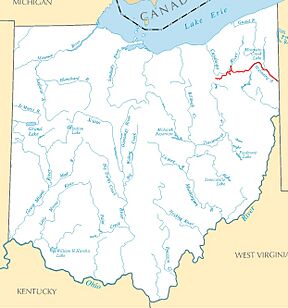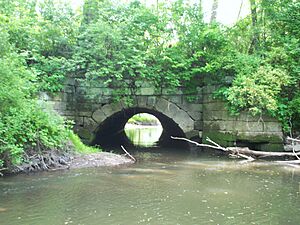Pennsylvania and Ohio Canal facts for kids
Quick facts for kids Pennsylvania and Ohio Canal |
|
|---|---|

A map of Pennsylvania's historic canals and connecting railroads
|
|
| Specifications | |
| Status | Generally abandoned except for historic interest |
| History | |
| Construction began | 1835 |
| Date completed | 1840 |
| Date closed | 1877 |
| Geography | |
| Start point | New Castle, Pennsylvania, U.S. |
| End point | Akron, Ohio, U.S. |
| Connects to | Beaver and Erie Canal, Ohio and Erie Canal |
| Pennsylvania and Ohio Canal: Ohio portion | |
|---|---|

Map of Ohio Portion of the P&O Canal
|
The Pennsylvania and Ohio Canal, also known as the P & O Canal, was an important shipping canal. It operated from 1840 until 1877. This canal connected other canals in two states: the Ohio and Erie Canal in Ohio and the Beaver and Erie Canal in Pennsylvania. Private companies paid for its construction.
Building the P&O Canal
People met in Warren, Ohio, on November 13, 1833. They decided to pay for the Pennsylvania and Ohio Canal themselves. Neither Ohio nor Pennsylvania wanted to spend state money on a canal that mostly helped another state.
Construction started on September 17, 1835. Engineers marked the "Portage Summit" in Ohio, near today's Kent and Ravenna. Workers dug the 82 miles (132 km) of canal by hand. They used picks, shovels, and wheelbarrows.
The canal stretched from New Castle, Pennsylvania to Akron, Ohio. In Akron, it joined the Ohio and Erie Canal. The canal followed old Native American paths. It also ran along the Cuyahoga and Mahoning Rivers. Water from Brady Lake and other sources in Northeast Ohio filled the canal.
On August 4, 1840, the canal officially opened. Big celebrations happened along its route!
How the Canal Changed Things

Like other canals, the P & O Canal used mules and horses. These animals pulled the canal boats. Goods and people traveled from Pittsburgh to Cleveland and Lake Erie using this canal and others.
This made trade much easier between Northeast Ohio and other Eastern states. Towns and villages along the canal grew bigger and richer. Some people also believe the canal helped the iron ore industry grow in the Mahoning Valley in Ohio.
The Canal's End
Over time, railroads became more popular. They were faster and could carry more goods. Because of this, the canal was used less and less.
By 1872, all parts of the canal were no longer used. The canal officially closed in 1877, and its land was sold. Today, you can still find parts of the old canal bed. You can see them in places like Munroe Falls, Ohio and downtown Kent, Ohio. In Kent, the Cuyahoga River now flows through where an old canal lock used to be. A culvert (like a small bridge for water) that carried the canal over Plum Creek still stands in southern Kent.
See also

